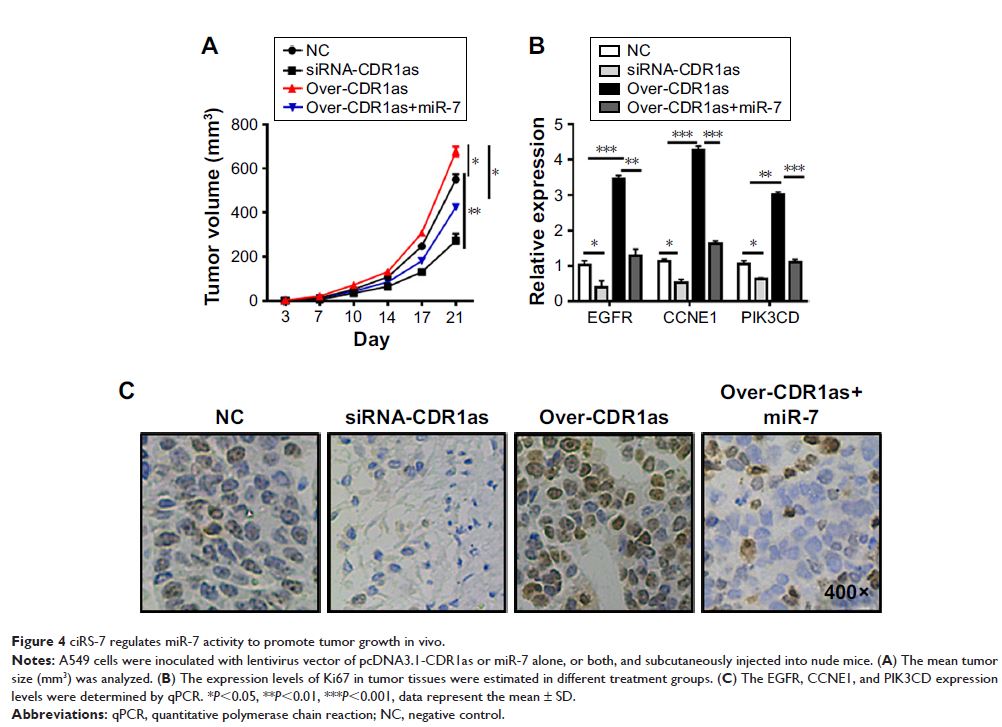9 0 7 9 9
论文已发表
注册即可获取德孚的最新动态
IF 收录期刊
- 2.6 Breast Cancer (Dove Med Press)
- 3.9 Clin Epidemiol
- 3.3 Cancer Manag Res
- 3.9 Infect Drug Resist
- 3.6 Clin Interv Aging
- 4.8 Drug Des Dev Ther
- 2.8 Int J Chronic Obstr
- 8.0 Int J Nanomed
- 2.3 Int J Women's Health
- 3.2 Neuropsych Dis Treat
- 4.0 OncoTargets Ther
- 2.2 Patient Prefer Adher
- 2.8 Ther Clin Risk Manag
- 2.7 J Pain Res
- 3.3 Diabet Metab Synd Ob
- 4.3 Psychol Res Behav Ma
- 3.4 Nat Sci Sleep
- 1.9 Pharmgenomics Pers Med
- 3.5 Risk Manag Healthc Policy
- 4.5 J Inflamm Res
- 2.3 Int J Gen Med
- 4.1 J Hepatocell Carcinoma
- 3.2 J Asthma Allergy
- 2.3 Clin Cosmet Investig Dermatol
- 3.3 J Multidiscip Healthc

过度表达的 CDR1as 作为癌基因通过 miR-7 在非小细胞肺癌中促进肿瘤进展
Authors Zhang X, Yang D, Wei Y
Received 28 November 2017
Accepted for publication 7 March 2018
Published 10 July 2018 Volume 2018:11 Pages 3979—3987
DOI https://doi.org/10.2147/OTT.S158316
Checked for plagiarism Yes
Review by Single-blind
Peer reviewers approved by Dr Colin Mak
Peer reviewer comments 2
Editor who approved publication: Dr Yao Dai
Background: Circular RNA (circRNA) is a novel member of the noncoding RNA and
function as efficient microRNA sponges with gene-regulatory potential,
especially the circular RNA ciRS-7 (CDR1as)/tumor suppressor miRNA-7 (miR-7)
signals. However, the function of CDR1as/miR-7 in non-small cell lung cancer
(NSCLC) is unknown.
Methods: Normal lung tissues (n=20), adjacent non-tumor tissues (n=60), and
NSCLC tissues (n=60) were collected to determine the expression and
significance of CDR1as/miR-7. Lung cancer cell lines A549 and H460 were
overexpressed or knocked down of CDR1as, miR-7 to determine the tumor growth
etc. The CDR1as/miR-7-related pathway were analyzed.
Results: CDR1as levels was robustly increased with the development of NSCLC
(P <0.001) and the NSCLC tissues
harbored highest expression of CDR1as, which negatively correlated to the
expression of miR-7. Patients with high expression of CDR1as had high TNM stage
(P =0.004), more lymph nodes
metastasis (LNM) (P =0.021) and shorted overall
survival time (OS) (P =0.0135). The
CDR1as level was an independent prognostic factor for the patients with NSCLC.
Overexpression of CDR1as induced increased cell vitalities and growth, which
could be abrogated by knockdown of CDR1as or overexpressed miR-7 to induce
apoptosis and G1/S arrest. Mechanistically, CDR1as functioned as miR-7 sponges
to up-regulate the key target genes of miR-7 including EGFR, CCNE1 and PIK3CD.
The results in vivo further confirmed that CDR1as functioned as oncogene to
inhibit the anti-tumor effects of tumor suppressor miR-7 by up-regulation of
proliferation index Ki-67, EGFR, CCNE1 and PIK3CD levels.
Conclusion: Overexpressed CDR1as in NSCLC functions promotes the tumor progression
via miR-7 signals.
Keywords: CDR1as, miR-7, prognosis, tumor growth, NSCLC
